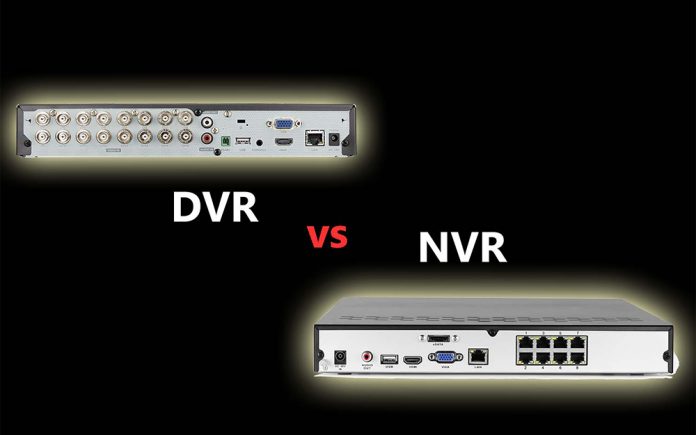
What is the difference and which one is better?
By Dennis Shelly
The use of video surveillance systems has become a necessity at both the business and household levels. They are used in a variety of critical and household applications to prevent crime and keep a place secure. Many people refuse to install a video surveillance system in and around their premises, however, in recent years, it has become a necessity for the general safety and security of people, as well as the privacy of data, and many other aspects. With so many security systems on the market, it’s important to pick the correct one for your company, along with the appropriate camera and other equipment. The two most prevalent types of video surveillance systems in use today are network video recorder (NVR) and digital video recorder (DVR). Both systems have gained popularity because of their features, but the choice is primarily dependent on the needs of your application. We’ll break down the differences and describe the benefits and drawbacks of each in this article so you can make an informed decision.
DVRs vs NVRs System – What is the Difference?
In principle, both NVR and DVR systems are capable of providing video recordings. They do, however, record the footage in different ways. The NVR system encrypts and processes data at the camera before transmitting it to the recorder for storage and remote viewing, whereas the DVR system processes data at the recorder. Both systems handle data in various ways. As a result, they require different camera types. DVRs are often used with analog cameras, whereas NVRs are typically used with IP cameras. The most crucial distinction is that a DVR-based surveillance system is a wired security system, but an NVR system may be either wired or wireless.
Pros and Cons of DVR systems and Differences in DVR System Components:
Analog Security Cameras: Analog security cameras are commonly used in DVR systems (otherwise known as CCTV cameras). Because of the camera, DVR security systems are often less expensive than NVR security systems. Analog cameras send analog inputs to the recorder, which analyses the video data. Most DVR cameras are less complicated and costly than NVR systems.
Coaxial Cables: The analog camera communicates with the DVR through a coaxial cable that can stretch up to 500 meters but has certain limits.
- Unlike PoE cables, coaxial cables do not provide power to the camera. This requires the use of two types of cables: one for power and one for video transmission.
- Because coaxial cables are wider and stiffer than Ethernet wires, they might be challenging to install.
- Standard coaxial cables do not allow audio transmission; therefore, this is a limitation.
AD Encoder: AD encoders convert raw video data from the camera into viewable footage for DVR recorders. As a result, each camera in a DVR system must be linked to the recorder as well as have its own power supply.
Audio Limitations: Standard coaxial cables do not carry audio signals by default; an additional RCA connection is required. The number of cameras that can capture sound is also limited by the number of audio input ports on DVR recorders.
Pros, Cons of NVR systems, and Differences in NVR System Components:
IP Cameras: IP cameras are used in NVR systems that are capable of processing video data before passing it to the recorder. IP cameras are usually more durable and can capture and send audio as well as images. IP cameras with advanced hardware enable intelligent video analytics such as license plates and face recognition.
Ethernet Cables: IP cameras often connect to the recorder through Ethernet cables if they aren’t wireless. They only have a 100-meter range, but they offer some benefits over coaxial cables.
- Some camera solutions may have a Power over Ethernet (PoE) connection, which means that power, video, and audio are all supported by a single cable. Splitters, which are often seen in DVR systems, are no longer required. However, it’s important to note that not all Ethernet-connected cameras support PoE; many IP cameras still require an Ethernet connection as well as a separate power supply.
- In comparison to coaxial cables, they are easier to install due to their smaller design, cost less, and are more readily available.
NVR recorder: The NVR recorder is solely used to record and view the footage. It doesn’t process video data, that is done before it’s sent to the recorder at the camera.
Both NVR and DVR systems are capable of recording video and are reliable. Although the video quality of DVR systems used to be inferior to that of equivalent NVR systems, this disparity has narrowed significantly in recent years. The cost, how the data is transmitted, and the type of cameras involved are the main differences between DVR and NVR security systems. NVR systems feature superior picture quality, are quicker to install, have more flexibility, and have native audio capabilities on every camera with a microphone. NVR systems, on the other hand, are typically more expensive than equivalent DVR systems, which is a crucial factor for budget-conscious consumers. A DVR system would most likely suffice for anyone searching for a simple security system, especially if your house is already wired for a coaxial cable for an existing security system. An NVR-based system may be the ideal option if you require a top-of-the-line, very flexible solution. At the end of the day, the deciding element will be your property’s specific security requirements.
You may still be wondering what to do, and if it’s time, how to choose your next surveillance system. This is where our Eggsperts can help! Our Eggsperts are eggcellent in helping with deciding which to choose, a DVR or NVR.
Have a suggestion for our next article? Please contact us by calling (760) 205-0105 or emailing us at tech@eggheadit.com and our Eggsperts are happy to help you with your questions or suggestions.
IT | Networks | Security | Phones | A/V | Integration












































